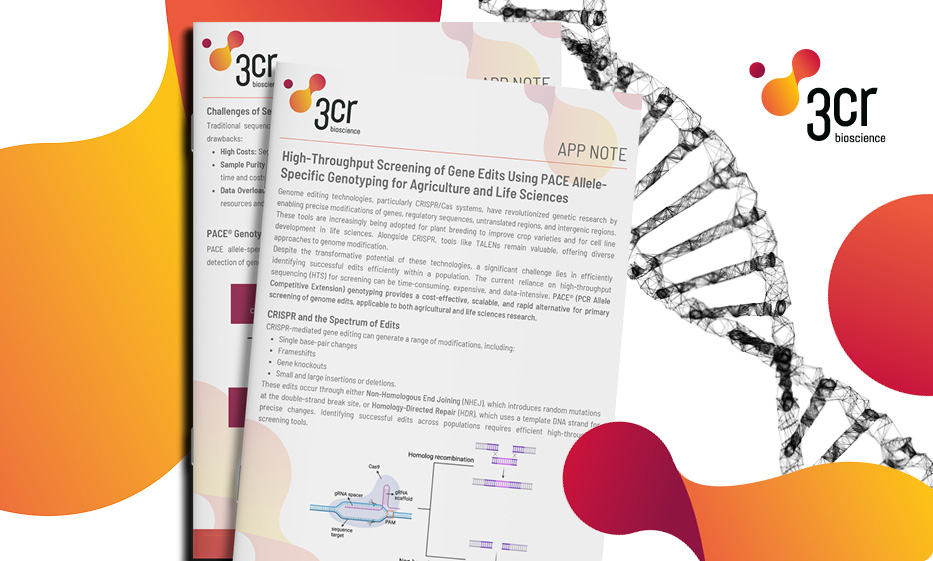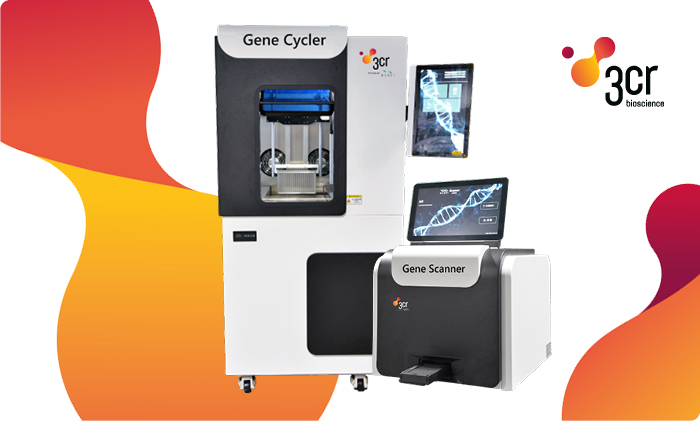The Challenge of DNA Extraction
SNP genotyping and molecular markers have revolutionized the fields of genomics for research, crop and livestock breed improvement, and seed purity testing, offering a fast and cost-effective approach. In the case of high-throughput plant genotyping, plants are typically genotyped from leaf tissue, necessitating the growth of the plant to the cotyledonary stage or its first true leaf. However, this process is time-consuming, space-intensive, and requires significant human resources, particularly at an industrial scale. A more efficient alternative is performing genetic screenings directly on seeds or early emerging roots (radicles), but the challenge lies in extracting DNA from seed tissue. Seeds are rich in reserve components like lipids, oils, proteins, polysaccharides, and polyphenols, which complicate DNA extraction. However, with the latest PACE 2.0 Genotyping Master Mix formulation, you can obtain superior data even from unpurified DNA samples.
While ultra-pure DNA is necessary for many genomic processes, for PCR genotyping, where only short stretches of DNA are amplified, crude DNA extractions such as the Hot Sodium Hydroxide and Tris (HotSHOT) methods are sufficient. When paired with an enhanced genotyping master mix like 3CR Bioscience’s PACE 2.0 Genotyping Master Mix, the need for extensive purification is eliminated.
Crude DNA Extraction Methods Overview
Crude DNA extraction involves collecting leaf, seed, or other tissue samples in 96-well plates and subjecting them to brief mechanical or chemical disruption to burst open the cells. In the simplest methods, cell lysates are centrifuged to pellet debris, and the remaining supernatant is diluted to reduce inhibitor compounds while retaining enough DNA for detection using genotyping assay primers. One commonly used method is the HotSHOT method, which is fast, inexpensive, and scalable. This method has been adapted for various tissues, including plants with high secondary metabolite concentrations, making it ideal for seed genotyping.
Example: Hop Plant DNA Prep Method
A modified HotSHOT DNA extraction method has been successfully adapted for hop plants (read the paper here), which are high in secondary metabolites. This custom extraction method is cost-effective, fast, and can be performed using basic laboratory equipment. The result is a reliable and efficient DNA extraction process that reduces both financial burden and time constraints, significantly increasing sample throughput.
Example: Carrot Seedling DNA Prep Method
For carrots, DNA extraction from young seedling tissue involves cell lysis using a tissue homogenizer (you can read the paper here). The crude extract, after brief centrifugation, is diluted to produce a final DNA solution suitable for PCR. This method is both efficient and cost-effective, providing a viable alternative to more time-consuming purification processes.
The Benefits of Crude DNA Preparation
High-quality DNA purification processes, while effective, are time-consuming and expensive. Crude DNA extraction methods offer a faster, more cost-effective alternative that is easily scalable. These methods are quicker, requiring fewer steps and reagents, and can be performed in high-throughput formats, making them ideal for downstream high-throughput genotyping. The primary benefits include:
Cost Savings: Significant reduction in expenses associated with DNA extraction kits and reagents.
Speed: Quicker preparation times compared to traditional purification methods.
Efficiency: Reduced manpower requirements and the ability to process large numbers of samples simultaneously.
The Drawbacks of Crude DNA Preparation
The primary drawback of crude DNA preparation is the lower quality of DNA compared to commercial extraction kits. For many applications, this lower quality is not sufficient. However, PCR genotyping is more forgiving, requiring only short DNA fragments. Crude DNA samples often contain compounds inhibitory to downstream PCR processes, such as polyphenols and polysaccharides. The challenge is to minimize and neutralize these inhibitors to ensure accurate and reliable results.
The Solution: PACE 2.0 Genotyping Master Mix
This advanced formulation of our patented PACE Genotyping Master Mix ensures consistent, accurate genotyping data without the need for extensive sample purification. By streamlining workflows and reducing costs, PACE 2.0 Genotyping Master Mix allows for high-throughput genotyping without compromising data quality.

Figure 1: SNP genotyping data generated using 1.6 μL final reaction volume on Array tape. Data from an undisclosed testing service company using crudely-extracted, PCR inhibitor-containing samples of globally-important agricultural crops, with purified control DNA samples (highlighted).
Features and Benefits
PACE 2.0 Genotyping Master Mix boasts several key features that make it ideal for use with crude DNA samples:
Inhibitor Resistance: Neutralizes PCR inhibitors present in crude DNA extracts from plant and animal samples.
Improved Signal-to-Noise Ratio: Enhanced fluorescent reporting system for better data quality.
No DNA Purification Required: Increases throughput while maintaining data integrity.
Compatibility: Works with a wide range of crude DNA extraction methods and is suitable for both endpoint and real-time PCR.
Case Studies
Case Study 1: Virginia-type Peanut
The North Carolina State University peanut breeding program has implemented a manual seed chipper and a crude DNA isolation protocol paired with PACE Genotyping Master Mix and PACE Genotyping Assays for an efficient, high-throughput workflow. This approach has enabled substantial expansion of marker-assisted selection (MAS) in their breeding program, achieving a genotyping success rate of 98.4% and significantly reducing resources required for greenhouse and field space (click here to read the paper).

Figure 2: Example marker figure produced by the SNP caller. Seeds homozygous for the HO mutation in FAD2B will produce predominantly HEX fluorescence signal and plot towards the Y-axis (blue cluster in top left corner). Seeds homozygous for the wild type NO allele in FAD2B will produce predominantly FAM fluorescence signal Page 16/16 and plot towards the X axis (green cluster in bottom right corner). Heterozygous seeds will produce an equal mix of both signals and cluster in red between the two homozygous clusters. Seeds that fail genotyping will cluster near the origin (yellow in bottom left corner).
Case Study 2: Hop Plants
In a recent hop plant study, researchers from the National Clonal Germplasm Repository, OR and Forage Seed and Cereal Unit, WA of the USDA-ARS used a modified HotSHOT DNA extraction method, combined with PACE 2.0 genotyping to enable rapid, cost-effective genotyping with high accuracy. This method has the potential to significantly reduce cultivar release timelines, reallocating resources to other areas of crop improvement. Find the article here.
Case Study 3: Carrot Seedlings
For carrot seedlings, DNA extraction using a tissue homogenizer followed by PACE 2.0 genotyping provided an efficient, cost-effective solution for researchers at the Department of Plant and Agroecosystem Sciences, University of Wisconsin-Madison. This method facilitated high-throughput genotyping, crucial for large-scale breeding programs (read the paper here).
Conclusion
Crude DNA extraction methods, paired with advanced solutions like PACE 2.0 Genotyping Master Mix and PACE Genotyping Assays, offer a powerful approach for high-throughput genotyping. By reducing costs and preparation times, these methods enable efficient and reliable genetic screenings, even from challenging starting materials. As demonstrated in various user case studies, the combination of crude DNA extraction and PACE® genotyping reagents can streamline workflows, increase sample throughput, and maintain high data quality, making them invaluable tools for modern genomics applications.
For more information on how PACE 2.0 Genotyping Master Mix can enhance your DNA extraction and genotyping workflows, email support@3crbio.com or visit our Applications page.



